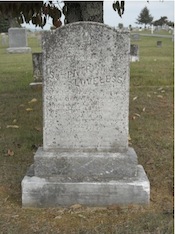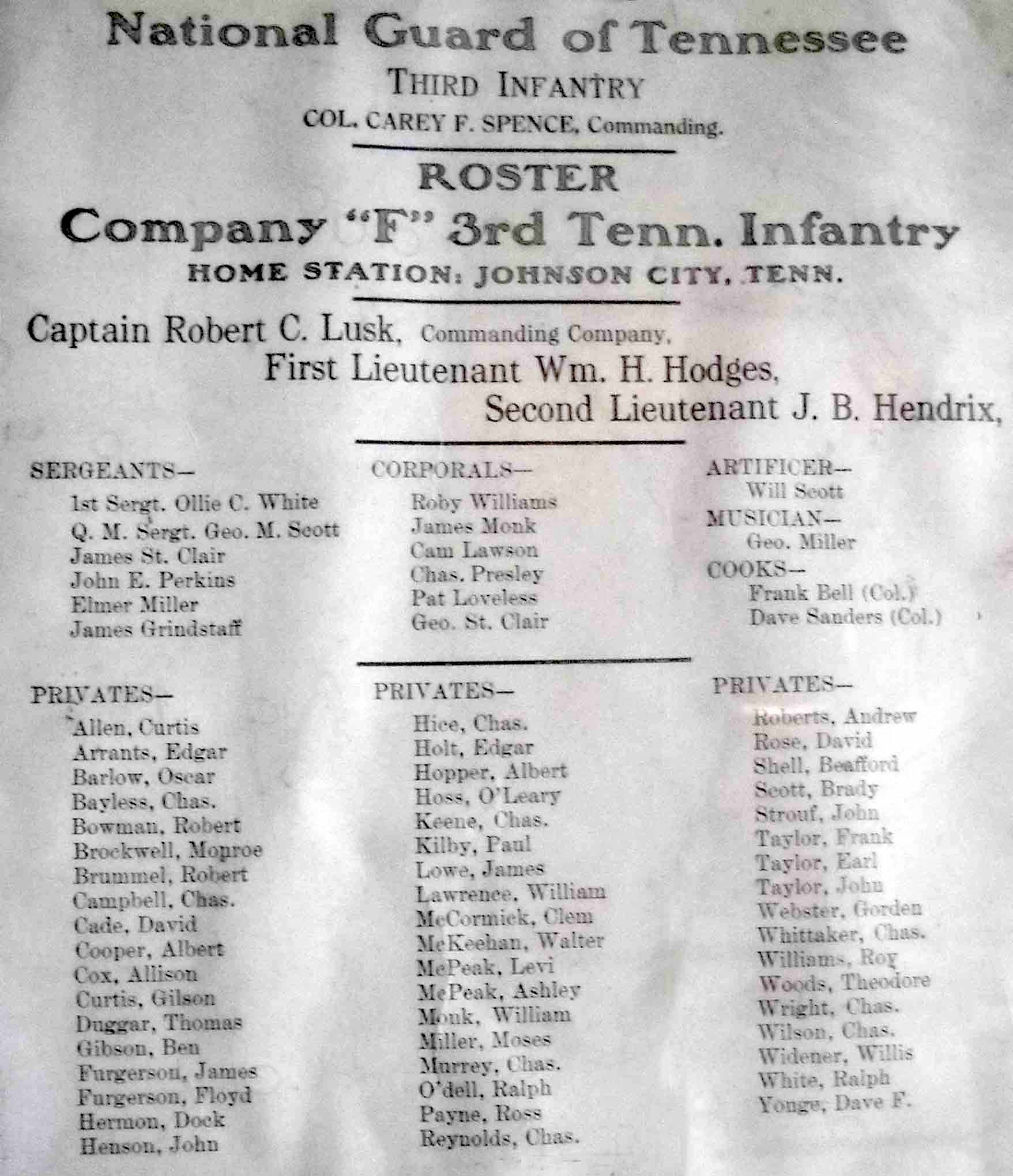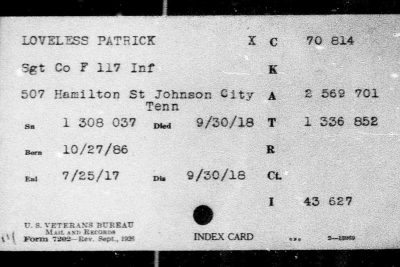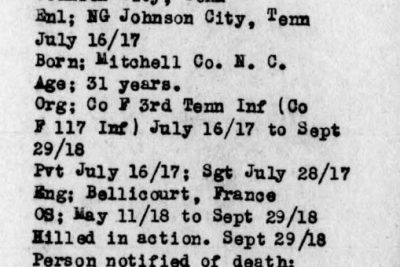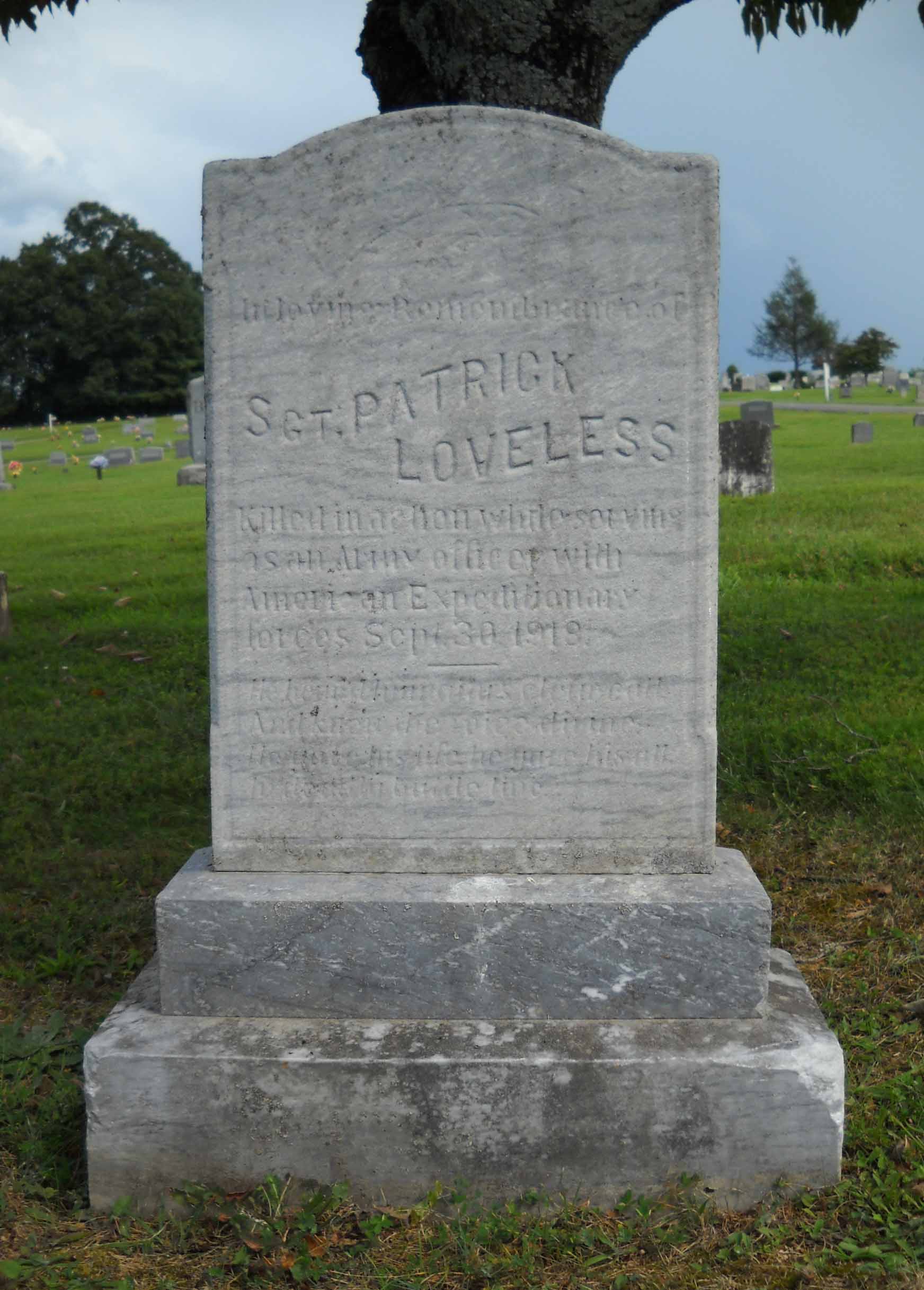Sergeant Patrick “Pat” Loveless, Service Number 1308037
Patrick was born on 27 October 1886 in Bakersville, Mitchell County, North Carolina. He moved to Johnson City, Washington County, Tennessee with his family and called it home. Patrick was employed as a Bottler with the Coca-Cola Bottling Works when he enlisted back into the Tennessee Army National Guard in Johnson City on 16 July 1917. He was also assigned back to Company F, 3rd Infantry Regiment as a Private even though he had previously held the rank of Corporal back in 1912.
The 3rd Infantry after being called to active service in the United States Army on 25 July 1917 would soon become part of the new 30th Division. Patrick was promoted to the rank of Sergeant three days later on 28 July. The quick promotion was due to his prior service history as a non-commissioned officer in Company F, 3rd Infantry. He and Company F were deployed to Camp Sevier, Greenville, South Carolina for training on 8 September. There they would join units from North and South Carolina, as well as those from Tennessee to form the core of the 30th Division, later known as the Old Hickory Division in honor of General and President Andrew Jackson. General Order No. 4 dated 12 September 1917, Headquarters 30th Division brought about a big change for Patrick and the 3rd. They were reorganized into the 117th Infantry Regiment under the 59th Infantry Brigade, Patrick stayed with Company F now part of the 2nd Battalion.
Patrick departed Camp Sevier on 5 May 1918 with Company F for Camp Mills, Long Island, New York to await transportation overseas. He along with others were given leave and for days afterwards and on the ship nursed sore necks from the hours they spent looking at all the tall skyscrapers of New York City. After boarding the SS Northumberland in Brooklyn, New York, they set off for Liverpool, England on 11 May and arrived on 23 May. After disembarking the ship he and the three infantry regiments of the 30th Division boarded troop trains and were taken to the port cities of Dover and Folkestone for the channel crossing over the next couple of days. He and his company arrived the port city of Calais, France on the 25th. As the 30th Division piecemealed into France just as they had done into England, they were taken to Audruicq by train and marched the short distance to the various towns and villages known as the Eperlecques Training Area in France. Patrick was billeted with the 117th at Nortbecourt and began Phase “A” Training with the British 39th Division on 10 June 1918.
Phase “A” was to be completed on 10 July, but was extended to the morning of 16 July. Phase “B” began the same day for the 30th Division with a three day march into Belgium. Upon arriving the Poperinghe Area, the 117th was billeted in one of the numerous camps and were intergraded over the next month into actual battlefield operations and trench warfare conditions with active combat units. Phase “B” was completed on 10 August and Phase “C” the last training phase was cancelled and the 30th were declared combat ready. Operational orders came in on the 14th and the 30th Division was to relieve the British 33rd Division starting the night of 16 August in the Canal Sector near Ypres, Belgium. The Ypres-Lys Offensive began on 19 August 1918 and the 30th would be in the thick of the fighting to the very end of the war.
Patrick and the 30th were given a breathing spell after being relieved from the Ypres-Lys Offensive on 5 September and were entrained to the St. Pol area and companies F, G & H of the 117th were billeted at Beauvois, France to resupply, do some more training and get a little rest from all the heavy artillery explosions. On the 17th the 30th Division made the move to the Puchevillers Area where they would come under the control of the 4th British Army on the 21st as would the American 27th Division to join in the Somme Offensive, also known as the One Hundred Day Offensive.
Patrick participated in two Unit Campaigns: Ypres-Lys Offensive in Belgium and the Somme Offensive in France. He also fought in the Battle of Bellicourt, also known as the Battle of St. Quentin Canal or the Bellicourt Tunnel on the Hindenburg Line. It was during this battle on its first day that Patrick lost his life on 29 September 1918, he was 31 years old. He was first interred at the Old Hickory #3 Military Cemetery near Bellicourt and later moved to the American Military Cemetery at Bony, France. Patrick was moved for a final time and reinterred at the Monte Vista Memorial Gardens, Section 14, Lot 17, Space 9 in Johnson City, Tennessee.
Patrick’s the son of William M. Loveless and Nannie McKinney. He was married to Mary. Patrick’s older brother James H. Loveless served in the United States Army with Company A, 4th Battalion, United States Guards at Camp Beauregard, Louisiana during the Great War (World War I).
— Submitted by Allen D. Jackson, USAF (Ret) Historian, Johnson City/Washington County TN Veterans Memorial Foundation
- Rank: Sergeant
- Date of birth: 27 October 1886
- Date of death: 29 September 1918
- County: Washington
- Hometown: Johnson City
- Service Branch: Army
- Division/Assignment: Company B, 117th Infantry Regiment, 30th Infantry Division
- Theater: Europe
- Conflict: World War I
- Battles: Ypres-Lys Offensive, Somme Offensive, Bellicourt
- Burial/Memorial Location: Monte Vista Memorial Park, Johnson City, Washington County, TN
- Location In Memorial: Pillar V, Middle Panel
- Contact us to sponsor Patrick Loveless
Image Gallery
Click a thumbnail below to view at full size.

